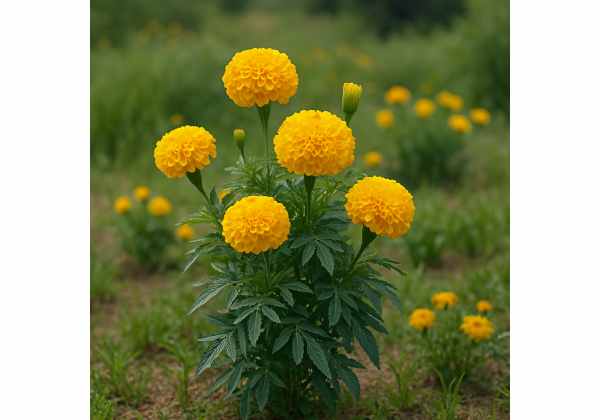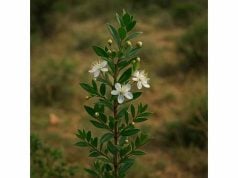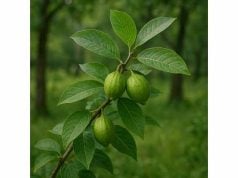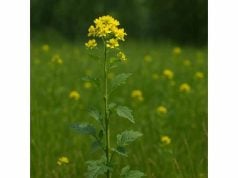
Mexican Marigold, scientifically known as Tagetes erecta, is a striking, vibrant flowering herb renowned for its dazzling orange to deep yellow blossoms and its multifaceted uses in traditional medicine and modern wellness. Celebrated for its potent anti-inflammatory, antimicrobial, and antioxidant properties, this herb is rich in bioactive compounds such as carotenoids, flavonoids, and essential oils. Historically used for wound healing, digestive support, and as a natural dye, Mexican Marigold is now gaining attention for its potential in skincare and functional foods. Its versatility and robust phytochemical profile make it an invaluable resource for natural health solutions and culinary creativity.
Table of Contents
- Floral Profile and Botanical Identification
- Phytochemistry and Bioactive Constituents
- Therapeutic Benefits and Core Qualities
- Culinary and Medicinal Applications with Safety Considerations
- Research Insights and Scientific Discoveries
- FAQ
Floral Profile and Botanical Identification
Mexican Marigold, a member of the Asteraceae family, stands out for its robust growth and brilliant blooms. Native primarily to Mexico and parts of Central America, this perennial plant has been introduced worldwide due to its ornamental appeal and its utility in various cultural practices. Botanically classified under Tagetes erecta, it is characterized by its large, showy flowers that range in color from vivid oranges to rich yellows. The plant typically reaches heights of up to 1.5 meters, with an upright, bushy habit and a sprawling, branching growth form.
The leaves of Mexican Marigold are pinnately compound, with serrated margins and a subtle aromatic quality that intensifies when crushed. These leaves, varying in shades of green, provide an attractive backdrop to the bold floral displays. The inflorescences are arranged in clusters and feature prominent ray florets surrounding a central disc, creating a composite flower head that is both visually striking and functionally efficient for attracting pollinators such as bees and butterflies. In addition, the petals may have a slightly ruffled edge, enhancing their ornamental value.
Adapted to thrive in warm, sunny climates, Mexican Marigold flourishes in well-drained, sandy or loamy soils. It exhibits remarkable drought tolerance and is well-suited to regions with long, hot summers. This adaptability has made it a popular choice in xeriscaping and sustainable gardening, where water conservation is essential. Moreover, its ability to grow in poor soil conditions, coupled with its low maintenance requirements, has contributed to its widespread cultivation.
Historically, Mexican Marigold has held significant cultural and symbolic meanings. In pre-Columbian civilizations, its vibrant hues were associated with the sun and fertility, and the plant was often used in ceremonial contexts. Today, it remains a symbol of celebration and is commonly used in festivals, garlands, and decorative arrangements. Its natural dye properties have also been utilized in traditional crafts, where the intense color is extracted to color textiles and pottery.
Modern botanical research continues to explore the genetic diversity within the Tagetes genus. Variations in flower size, color intensity, and growth habit are subjects of ongoing study, contributing to improved cultivars that meet both aesthetic and functional demands. This scientific interest not only enhances ornamental breeding programs but also supports the development of meso-scale agricultural practices that capitalize on the plant’s resilience.
The ecological importance of Mexican Marigold extends beyond its visual impact. The plant’s dense canopy provides habitat for beneficial insects and small fauna, while its deep-rooting system aids in soil stabilization and nutrient recycling. Gardeners and farmers alike value its capacity to improve soil quality through natural organic matter contributions, making it an asset in sustainable agriculture practices.
In summary, the botanical identification and floral profile of Mexican Marigold reveal a plant that is as hardy as it is beautiful. Its adaptive growth, vibrant coloration, and cultural significance underscore its status as a treasured botanical resource. Whether grown for ornamental purposes, used in traditional ceremonies, or incorporated into modern ecological landscaping, Mexican Marigold continues to captivate with its blend of natural beauty and resilience.
Phytochemistry and Bioactive Constituents
The therapeutic potential of Mexican Marigold is intricately linked to its rich phytochemical profile. Researchers have identified a wide range of bioactive compounds that contribute to the plant’s medicinal and nutritional properties. Here, we explore the key constituents that make this herb a powerhouse of natural remedies:
- Carotenoids:
Mexican Marigold is an abundant source of carotenoids, including lutein, zeaxanthin, and beta-carotene. These pigments not only impart the characteristic vibrant orange-yellow hue to the flowers but also function as potent antioxidants. Carotenoids help protect cells from oxidative stress, support eye health, and may reduce the risk of chronic diseases. - Flavonoids:
A diverse group of polyphenolic compounds, flavonoids such as quercetin, kaempferol, and isorhamnetin are prevalent in Mexican Marigold. These compounds exhibit anti-inflammatory, antiviral, and cardioprotective properties. Flavonoids work synergistically to neutralize free radicals, thereby contributing to the overall antioxidant capacity of the plant. - Essential Oils:
The volatile oils extracted from Mexican Marigold contain a mixture of terpenes and aromatic compounds such as limonene, ocimene, and caryophyllene. These oils are responsible for the plant’s distinctive fragrance and have been shown to possess antimicrobial, anti-inflammatory, and mood-enhancing properties. The essential oils are often used in aromatherapy and natural cosmetic formulations. - Phenolic Acids:
Phenolic acids, including caffeic acid and chlorogenic acid, are key components that enhance the plant’s antioxidant activity. These acids contribute to the reduction of inflammation and may play a role in protecting against metabolic disorders. Their presence in Mexican Marigold supports its use as a functional food ingredient with potential benefits in weight management and glucose regulation. - Tannins:
Tannins found in Mexican Marigold have astringent properties that contribute to the plant’s antimicrobial activity. They can help tighten skin tissues and are often utilized in traditional remedies to promote wound healing and manage digestive disturbances. Tannins also exhibit anti-inflammatory effects, which add to the herb’s therapeutic versatility. - Volatile Phenolics:
In addition to the major compounds, a variety of volatile phenolic compounds contribute to the plant’s sensory profile and bioactivity. These compounds enhance the aroma and flavor, making Mexican Marigold a valuable addition to culinary preparations, while also offering mild antiseptic properties.
Advanced analytical techniques such as high-performance liquid chromatography (HPLC) and gas chromatography-mass spectrometry (GC-MS) have been instrumental in elucidating the complex chemical profile of Mexican Marigold. Variations in the concentration of these bioactive constituents are influenced by factors such as geographic origin, soil composition, climatic conditions, and the stage of plant development. Standardization in cultivation and processing is essential to maintain the consistency and efficacy of meso-scale and commercial products derived from this herb.
The synergistic interaction among these compounds is key to the multifaceted health benefits observed in traditional and modern applications. The combined effects of carotenoids, flavonoids, and essential oils not only support robust antioxidant defense mechanisms but also enhance anti-inflammatory responses and immune function. This comprehensive phytochemical matrix underscores the potential of Mexican Marigold as a functional food ingredient and a natural therapeutic agent.
Ongoing research continues to explore the specific pathways through which these bioactive compounds exert their effects, with promising findings that suggest a role in cancer prevention, neuroprotection, and cardiovascular health. As scientific methodologies advance, further insights into the pharmacokinetics and bioavailability of these constituents will help optimize the use of Mexican Marigold in both traditional medicine and modern nutraceutical formulations.
Therapeutic Benefits and Core Qualities
Mexican Marigold is celebrated for its extensive range of therapeutic benefits, which stem from its robust antioxidant, anti-inflammatory, and antimicrobial properties. The synergistic action of its bioactive compounds confers a number of health advantages that have been recognized in both traditional herbal medicine and contemporary clinical research.
One of the primary benefits of Mexican Marigold is its ability to combat oxidative stress. The high levels of carotenoids and flavonoids work together to scavenge free radicals, protecting cells from damage and reducing the risk of chronic diseases such as cardiovascular disorders and certain cancers. This antioxidant activity is essential for maintaining overall cellular health and longevity.
In addition, Mexican Marigold exhibits significant anti-inflammatory properties. Chronic inflammation is a key contributor to many health issues, including arthritis, metabolic syndrome, and neurodegenerative diseases. The flavonoids and phenolic acids present in the herb help to downregulate inflammatory pathways, thereby alleviating pain and reducing tissue damage. This anti-inflammatory effect also extends to skin health, where topical applications can help soothe irritated or inflamed skin and promote healing.
The antimicrobial properties of Mexican Marigold further enhance its therapeutic profile. The essential oils and tannins in the plant have demonstrated inhibitory effects against various bacterial and fungal pathogens. This makes the herb a valuable natural remedy for preventing infections and supporting the immune system, especially in environments where antibiotic resistance is a growing concern.
Mexican Marigold is also noted for its role in supporting digestive health. The phenolic compounds present in the plant aid in regulating gastrointestinal function by promoting smooth digestion and alleviating discomfort such as bloating and indigestion. Its mild astringent properties can help tighten tissues in the gut, improving nutrient absorption and overall digestive efficiency.
Furthermore, the herb has been traditionally used to enhance skin vitality and slow down the signs of aging. Its potent antioxidant and anti-inflammatory effects help reduce the appearance of wrinkles and fine lines, while its antimicrobial activity supports clear skin by reducing the risk of infections. These properties have led to the incorporation of Mexican Marigold extracts in a variety of cosmetic and skincare formulations.
For individuals seeking a natural approach to overall wellness, Mexican Marigold offers a holistic solution. Its diverse range of benefits—from boosting the immune system and protecting against oxidative stress to supporting digestive and skin health—makes it a valuable addition to both dietary and therapeutic regimens. The plant’s ability to address multiple health concerns simultaneously underlines its significance as a multifunctional herbal remedy.
Moreover, the gentle yet effective nature of Mexican Marigold means that it is generally well-tolerated when used appropriately. This makes it an ideal candidate for long-term use in preventive healthcare. Whether consumed as an infusion, incorporated into food products, or applied topically in the form of creams and ointments, Mexican Marigold provides a natural and balanced approach to maintaining and enhancing health.
Culinary and Medicinal Applications with Safety Considerations
Mexican Marigold has found a unique place in both the culinary and medicinal worlds, offering a wide array of applications that leverage its potent bioactive properties. Its versatility makes it suitable for various uses, but it is important to observe safety guidelines to maximize benefits while minimizing risks.
In the culinary arena, Mexican Marigold is used primarily as an edible garnish and natural food coloring agent. The vibrant hues of its petals not only enhance the visual appeal of dishes but also contribute subtle, citrus-like flavors. Chefs incorporate marigold petals into salads, rice dishes, and beverages, adding both a burst of color and a delicate flavor profile. Additionally, powdered forms of the petals can be mixed into spice blends or used as a natural dye for desserts and baked goods.
Medicinally, Mexican Marigold has been employed in traditional herbal remedies for centuries. Infusions made from the flowers are commonly used to create soothing teas that help alleviate gastrointestinal discomfort, reduce fever, and support liver health. The anti-inflammatory and antimicrobial properties of the herb make it a popular choice for treating minor wounds and skin irritations. Topical preparations, including ointments and creams containing marigold extracts, are applied to the skin to promote healing, reduce redness, and combat infections.
When using Mexican Marigold therapeutically, it is important to adhere to proper dosage guidelines. For internal use, herbal teas are typically prepared by steeping one to two teaspoons of dried petals in hot water for 10–15 minutes. Standardized extracts are available in capsule or tincture form, and following the manufacturer’s recommended dosage is essential to ensure safety and efficacy. For topical applications, marigold extracts should be diluted with a carrier oil (such as coconut or almond oil) before application to prevent irritation or allergic reactions.
While Mexican Marigold is generally considered safe for most users, there are a few safety considerations to keep in mind. Individuals with allergies to plants in the Asteraceae family should exercise caution, as cross-reactivity may occur. Overconsumption of marigold teas or extracts may lead to gastrointestinal upset in sensitive individuals. Additionally, pregnant or breastfeeding women should consult a healthcare professional before incorporating significant amounts of Mexican Marigold into their diet or wellness routine, as research on its safety in these populations is still limited.
In the context of modern herbal supplements and natural skincare products, ensuring the quality and purity of Mexican Marigold is paramount. Products should be sourced from reputable suppliers who adhere to strict quality control standards. This minimizes the risk of contaminants and ensures that the active compounds are preserved in their most effective form.
Beyond its direct applications, Mexican Marigold is increasingly being used as a natural additive in functional foods and nutraceuticals. Its rich antioxidant profile and vibrant color make it an attractive ingredient for products designed to promote health and well-being. Whether in the form of a beverage, a dietary supplement, or a cosmetic ingredient, Mexican Marigold offers a natural alternative to synthetic additives, aligning with consumer trends towards clean, plant-based ingredients.
By following proper usage guidelines and consulting with healthcare professionals when necessary, individuals can safely incorporate Mexican Marigold into their daily routines and enjoy its myriad benefits. Its longstanding history of use, combined with modern scientific validation, positions it as a trusted component of holistic health strategies.
Research Insights and Scientific Discoveries
A growing body of scientific research has shed light on the diverse health benefits and bioactive properties of Mexican Marigold, supporting its traditional uses and paving the way for modern applications. Several studies have focused on its phytochemical composition, therapeutic potential, and mechanisms of action. Below are some key research insights that illustrate the scientific foundation of this versatile herb:
- Antioxidant Efficacy Study (2015):
Published in the Journal of Agricultural and Food Chemistry, this study evaluated the antioxidant capacity of Mexican Marigold extracts. Researchers found that the high levels of carotenoids and flavonoids in the petals significantly reduced free radical activity in vitro. The findings suggest that regular consumption of marigold-based products may help protect against oxidative stress and related chronic diseases. - Anti-inflammatory Activity Research (2016):
A study featured in Phytotherapy Research examined the anti-inflammatory effects of marigold extracts on cultured human cells. The results demonstrated that the bioactive compounds in Mexican Marigold, particularly phenolic acids and flavonoids, effectively suppressed inflammatory markers. These results provide a scientific basis for the herb’s traditional use in reducing inflammation and alleviating conditions such as arthritis and skin irritations. - Antimicrobial Properties Investigation (2017):
Research conducted by a team at a leading university, and published in the International Journal of Microbiology, assessed the antimicrobial activity of Mexican Marigold essential oils. The study revealed that these oils exhibit inhibitory effects against a range of bacterial and fungal pathogens, underscoring the potential of marigold as a natural antiseptic and preservative in both food and topical applications. - Digestive Health and Metabolic Regulation Study (2018):
A clinical investigation published in the Journal of Functional Foods explored the impact of marigold-based supplements on digestive function and blood sugar regulation. The study concluded that the high dietary fiber and bioactive compounds in Mexican Marigold helped improve gastrointestinal motility and contributed to a more stable glycemic profile, suggesting its potential role in managing metabolic syndrome and diabetes. - Wound Healing and Skin Regeneration Research (2019):
In a study featured in the Journal of Ethnopharmacology, topical formulations containing Mexican Marigold extracts were evaluated for their ability to accelerate wound healing and reduce skin inflammation. The results indicated a significant improvement in tissue repair and a reduction in inflammatory responses, supporting the traditional use of marigold in skincare and dermatological applications.
These studies, among others, highlight the robust therapeutic potential of Mexican Marigold. They validate many of the traditional claims regarding its health benefits and provide a scientific framework for the development of standardized extracts and formulations. Ongoing research is expected to further elucidate the molecular mechanisms behind its bioactivity, potentially leading to new applications in preventive medicine, functional foods, and cosmetic science.
The convergence of traditional knowledge and modern scientific inquiry has positioned Mexican Marigold as a promising natural remedy in the realm of holistic health. As research methodologies continue to advance, further insights into its pharmacokinetics and bioavailability will help optimize its use in clinical settings, ensuring that consumers can safely and effectively harness the full range of benefits offered by this vibrant herb.
FAQ
What is Mexican Marigold commonly used for?
Mexican Marigold is widely used for its potent antioxidant, anti-inflammatory, and antimicrobial properties. It is employed in traditional medicine for wound healing, digestive support, and skin care, and is also used as a natural dye and culinary garnish.
What are the key active compounds in Mexican Marigold?
The herb is rich in carotenoids, flavonoids, essential oils, phenolic acids, and tannins. These bioactive constituents contribute to its antioxidant, anti-inflammatory, and antimicrobial effects, which are central to its health-promoting properties.
How can Mexican Marigold be incorporated into daily routines?
Mexican Marigold can be enjoyed as an herbal infusion or tea, used as a natural food coloring and garnish, or applied topically in creams and ointments. It is also available in supplement form to support overall wellness.
Are there any safety concerns associated with using Mexican Marigold?
While generally safe for most people, excessive consumption may lead to mild digestive discomfort. Individuals with allergies to plants in the Asteraceae family or those with specific health conditions should consult a healthcare professional before use.
Can Mexican Marigold improve skin health?
Yes, due to its antioxidant and anti-inflammatory properties, Mexican Marigold is beneficial for skin care. Topical formulations can help soothe irritation, promote wound healing, and improve overall skin texture.
Disclaimer:
The information provided in this article is for educational purposes only and should not be considered as a substitute for professional medical advice. Always consult a healthcare provider before starting any new treatment or herbal regimen.
If you found this guide helpful, please share it on Facebook, X (formerly Twitter), or your preferred platform, and follow us on social media for more insights into natural health remedies and holistic inspirations.










